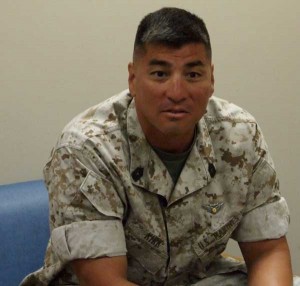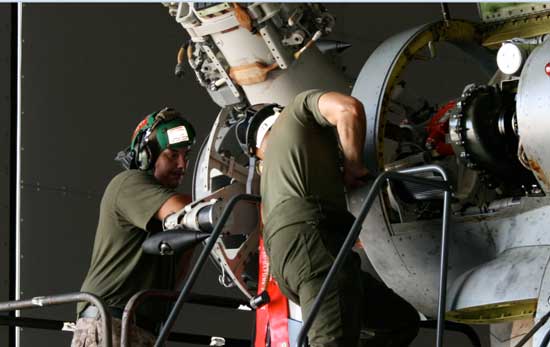An Update on the Osprey From New River (VIII)
An Interview With Master Sgt. Jeremy Kirk
12/21/2010 – Master Sgt. Jeremy Kirk discussed his experience with maintaining the V-22. As an experience CH-46 maintainer he underscored that the Corps had decades of experience maintaining this rotorcraft. The V-22 is new and has the norm shake down challenges in operational deployments. The maintainers are shaping a regime to understand the new aircraft and how to maintain it in operations. He underscored that there are challenges, but “it takes time to learn how to maintain a new aircraft.”

SLD: Could you give us a sense of your background in maintenance?
Master Sergeant Kirk: I was a FROG guy from the get-go. With the 265, I did the Desert Storm, Desert Shield deployments, and numerous support operations out to Okinawa. I did a little stint in NATO, did the rework thing for a while for four years, and got to 263 in ’02 and did all the same deployments as Major York.
We went to Europe, spent nine months on a boat, quick turnaround, back out with the big Iraq operation. Then in 04 to 05 was in the Fallujah operation and I flew the whole time I was a crew chief originally.
I then did the transition to the V-22. I was with 263, then with the transition and then a month prior to them deploying I hurt my back. I had to have surgery. I went to 204 to do the training for a couple of years rehab, got back out at 264 and then got promoted to a job of the maintenance control chief. I’ve been around maintenance for a little bit.
SLD: What are the differences between maintaining a FROG and a V-22?
Master Sergeant Kirk: There are differences. One of the biggest differences is the lack of experienced maintainers for the V-22. With the FROG being around for so long we have decades of experience with that experience in the minds of the maintainers. We are still learning the V-22. You have younger marines and a new aircraft.
Working on the Aircraft at New River, August 2010 (Credit: SLD)
SLD: The interaction between the novelty of the aircraft, lack of maintenance experience and challenges in the supply chain obviously created a challenge.
Master Sergeant Kirk: Yes one problem was that the expectation of part life was difference from the experience. So we need to close the gap. We are trying to learn the gap. Because parts weren’t lasting as long as they were supposed to last, we were fixing them faster than you anticipated.
SLD: The metrics of performance for the parts were out of whack with the operational experience?
Master Sergeant Kirk: Absolutely. For example, a prop box, a huge transmission inside the nacelle, which is supposed to work for 5800 hours when we get them out of the factory, last considerably less. We’re changing these gearboxes faster than we need to.
One problem was that the expectation of part life was difference from the experience. So we need to close the gap. We are trying to learn the gap. Because parts weren’t lasting as long as they were supposed to last, we were fixing them faster than you anticipated. For example, a prop box, a huge transmission inside the nacelle, which is supposed to work for 5800 hours when we get them out of the factory, last considerably less. We’re changing these gearboxes faster than we need to.
SLD: Another issue we discussed earlier was that improved simplification for access to change parts is underway as well : we discussed challenges in getting the gearbox off for repair.

Master Sergeant Kirk: Repairing the gearbox entails taking the engine, taking the hub off, taking everything off and then all of skin around it needs to come out also. It’s a pretty maintenance intensive task there.
SLD: What improvements are you seeing in terms of the ability to maintain the aircraft?
Master Sergeant Kirk: Honestly, I like this aircraft. I was a FROG guy for 16 1/2 years but you can definitely see the worth of the V-22. It can do a lot of things. It would make our job a lot easier if things just lasted longer.
I can see significant improvements from ’05 to now from just the experience levels of maintainers learning their tasks and learning the tricks of the trade on the new aircraft. And I think you have seen it on the pilot side also. We just needed to have the aircraft deployed actually to learn how we were going to employ it, and how we’re going to maintain it.
SLD: So your point that you got the aircraft, you got it into service and have four or five years of experience now, maintenance is getting better.
Master Sergeant Kirk: Yes.
SLD: But you are also pointing out that the initial maintenance of the aircraft has required a lot of adjustments, and that’s okay for a while but that obviously is not a prescription for normal operation. Is that a fair observation?
Master Sergeant Kirk: I think it’s a very fair observation. We take parts off the factory to support aircraft. I’m sure that last V-22 that rolls out of the factory is going to be missing quite a few parts just because they’re not available for the rest of them.
SLD: So parts availability is an issue as well as durability of parts.
Working on the Bird With Trained Hands, New River Air Station, August 2010 (Credit: SLD)
Master Sergeant Kirk: Parts availability, and durability. For example, you see the Marines all the time dealing with the oil coolers; we always have hot oil coolers. We’re always cleaning them out. In order for the Marine actually to clean it, he’s got to pull off all those panels and pull it apart to get inside and clean it. If there is a more expeditious way to clean it that would be the way we’d want to go.
SLD: I think part of the problem is nobody has ever operated tiltrotor aircraft.
Master Sergeant Kirk: Absolutely. We’ve come leaps and bounds in the five years that I’ve been involved. But it does take time.

